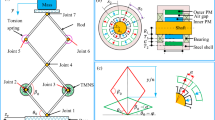Abstract
In this paper the computational methodology for evaluating vibro-isolation properties of the vibration reduction systems is discussed. The proposed procedure supports selecting the non-linear dynamic behaviour of passive systems and helps to perform the controller synthesis of active systems. Primarily, the mathematical model of a vibration reduction system is developed for the purpose of simulating its dynamic behaviour under different operating conditions. In the next step, the selected vibro-isolation criteria are determined numerically that are related to the opposed requirements of modern vibration reduction systems. Finally, an application of the Pareto-optimal approach is employed to find a trade-off regarding the high efficiency of vibration attenuation at the lowest suspension travel.
Similar content being viewed by others
Abbreviations
- C i :
-
Matrix of stiffness coefficients
- D i :
-
Matrix of damping coefficients
- F si :
-
Vector of passive forces
- F ai :
-
Vector of active forces
- M i :
-
Mass matrix
- SEAT x :
-
Seat effective amplitude transmissibility factor
- q i :
-
Displacement vector
- S ti :
-
Suspension travel
References
Directive 2002/44/EC of the European Parliament and of the Council, On the minimum health and safety requirements regarding the exposure of workers to the risks arising from physical agents (vibration), Official Journal of the European Communities (2002) 13–18.
G. Paddan and M. Griffin, Use of seating to control exposures to whole-body vibration, Health and Safety Executive, London (2001).
I. Maciejewski, L. Meyer and T. Krzyzynski, Modelling and multi-criteria optimisation of passive seat suspension vibro-isolating properties, Journal of Sound and Vibration, 324 (2009) 520–538.
R. Alkhatiba, G. Nakhaie Jazarb and M. F. Golnaraghi, Optimal design of passive linear suspension using genetic algorithm, Journal of Sound and Vibration, 275 (2004) 665–691.
J. Konieczny, J. Kowal, W. Raczka and M. Siebielak, Bench tests of slow and full active suspensions in terms of energy consumption, Journal of Low Frequency Noise Vibration and Active Control, 32(1–2) (2013) 81–98.
S. F. Youness and E. C. Lobusov, Networked control for active suspension system, Procedia Computer Science, 150 (2019) 123–130.
G. Papaioannou and D. Koulocheris, An approach for minimizing the number of objective functions in the optimization of vehicle suspension systems, Journal of Sound and Vibration, 435 (2018) 149–169.
S. Segla, Modelling and optimization of passive and semi-active suspension of a 3 DOF seat platform, Advances in Mechanism and Machine Science — Mechanisms and Machine Science, Springer, 73 (2019) 4075–4084.
H. Zhu, J. Yang and Y. Zhang, Modeling and optimization for pneumatically pitch-interconnected suspensions of a vehicle, Journal of Sound and Vibration, 432 (2018) 290–309.
M. A. Oliver-Salazar, D. Szwedowicz-Wasik, A. Blanco-Ortega, F. Aguilar-Acevedo and R. Ruiz-Gonzalez, Characterization of pneumatic muscles and their use for the position control of a mechatronic finger, Mechatronics, 42 (2017) 25–40.
W. Scaff, O. Horikawa, M. Sales and T. Suzuki, Pneumatic artificial muscle optimal control with simulated annealing, IFAC PapersOnLine, 51–27 (2018) 333–338.
C. M. Close, D. K. Frederick and J. C. Newell, Modeling and Analysis of Dynamic Systems, 3rd Edition, John Wiley, New York (2001).
S. Rutzel, B. Hinz and H. B. Wolfel, Modal description-a better way of characterizing human vibration behavior, Journal of Sound and Vibration, 298 (2006) 810–823.
M. Toward and J. Griffin, The transmission of vertical vibration through seats: Influence of the characteristics of the human body, Journal of Sound and Vibration, 330 (2011) 6526–6543.
G. J. Stein, P. Muka, R. Chmurny, B. Hinz and R. Bluthner, Measurement and modelling of x-direction apparent mass of the seated human body-cushioned seat system, Journal of Biomechanics, 40 (2007) 1493–1503.
I. Maciejewski, T. Krzyzynski, L. Meyer and H. Meyer, Shaping the vibro-isolation properties of horizontal seat suspension, Journal of Low Frequency Noise, Vibration and Active Control, 36(3) (2017) 203–213.
I. Maciejewski, T. Krzyzynski and H. Meyer, Modeling and vibration control of an active horizontal seat suspension with pneumatic muscles, Journal of Vibration and Control, 24(24) (2018) 5938–5950.
I. Maciejewskil, L. Meyer and T. Krzyzynski, The vibration damping effectiveness of an active seat suspension system and its robustness to varying mass loading, Journal of Sound and Vibration, 329 (2010) 3898–3914.
ISO 2631:1997, Mechanical Vibration and Shock — Evaluation of Human Exposure to Whole-Body Vibration, International Organization for Standardization, Geneva, Switzerland (1997).
ISO 7096:2000, Earth-Moving Machinery — Laboratory Evaluation of Operator Seat Vibration, International Organization for Standardization, Geneva, Switzerland (2000).
Acknowledgments
The assistance in the experimental research of Isringhausen GMBH and Co. KG is highly appreciated.
Author information
Authors and Affiliations
Corresponding author
Additional information
Igor Maciejewski is an Associated Professor at the Koszalin University of Technology in Poland. He received D.Sc. in the field of machine design and operation in 2013. His research is focused on shaping the vibro-isolation properties of vibration reduction systems, especially applied to protect the operators of working machines.
Mariusz Zlobinski is a Ph.D. student at the Koszalin University of Technology, Poland. He received M.Sc. in the field of mechatronics in 2018. His research regards active vibration control by means of complex control algorithms.
Tomasz Krzyzynski is a Full Professor of Applied Mechanics at the Koszalin University of Technology, Poland. He received his Ph.D. (1987) and D.Sc. (1997) at the Institute of Fundamental Technological Research of the Polish Academy of Sciences. His research is focused on dynamical analysis of mechatronic systems.
Rights and permissions
About this article
Cite this article
Maciejewski, I., Zlobinski, M. & Krzyzynski, T. Optimal design of vibration-isolation systems by means of a numerical simulation. J Mech Sci Technol 35, 3887–3894 (2021). https://doi.org/10.1007/s12206-021-0802-y
Received:
Revised:
Accepted:
Published:
Issue Date:
DOI: https://doi.org/10.1007/s12206-021-0802-y




